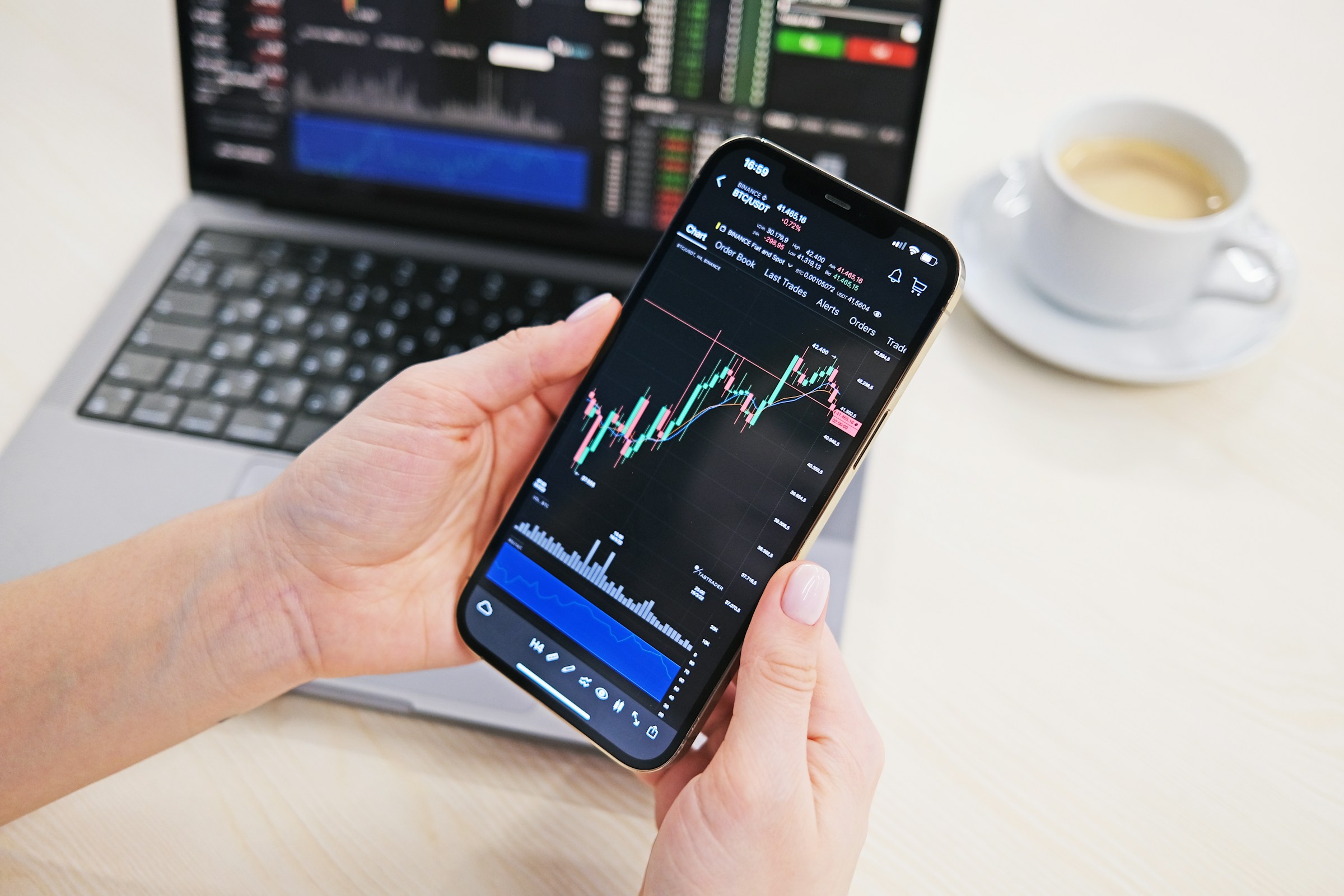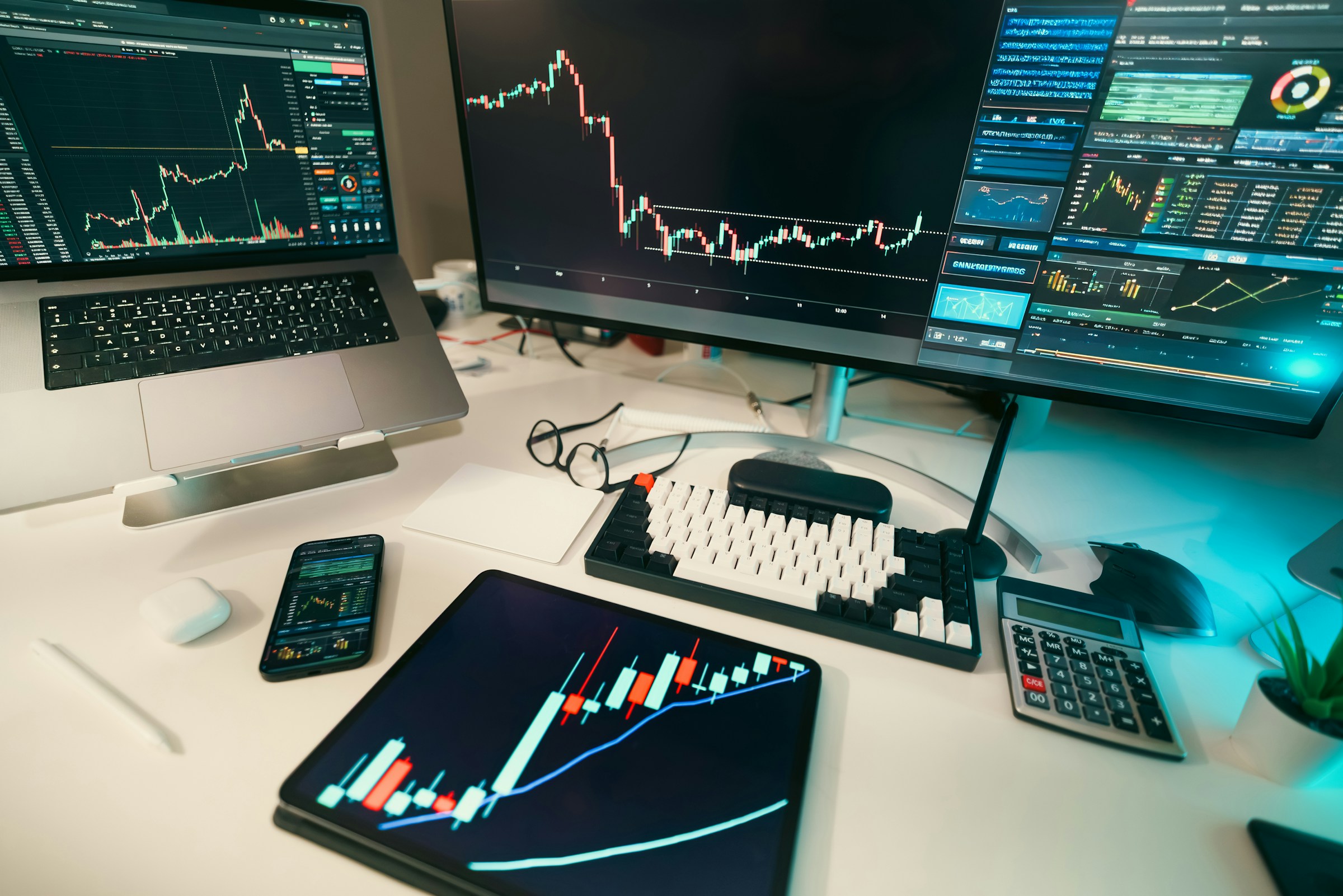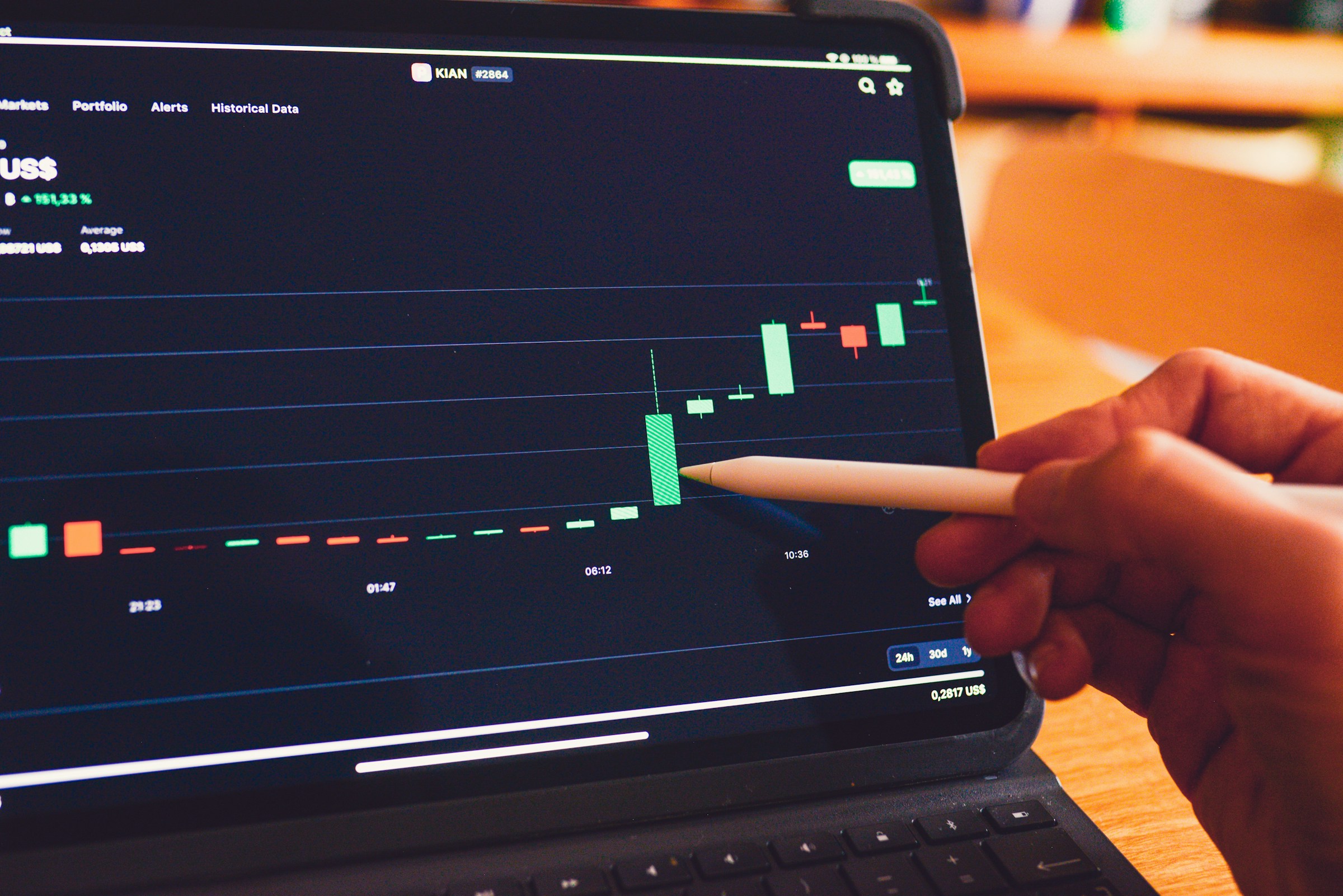Learn how AI algorithmic financial trading works, including key strategies, benefits, and real-world applications to improve trading efficiency.
.jpg)
Imagine waking up in the morning and checking your stock portfolio only to find that an automated trading bot had made you thousands of dollars while you slept. This is the power of trading using AI. Algorithmic trading systems can analyze financial data and identify patterns and trends faster than any human is capable of.
The result is that you achieve smarter, faster, and more profitable financial trades, all while you take care of other business or rest easy at night. In this guide, we'll explore AI algorithmic financial trading and how to use it to your advantage. You'll learn how these systems work, the benefits they offer, and how to get started so you can confidently make better trades with algorithms.
One of the best ways to get started with AI algorithmic trading is to find a reliable trading bot to help you achieve your goals. The experts at Trading Bot Experts’ best trading bots can help you do just that. Their website provides in-depth reviews of the top trading bots available on the market.

AI Algorithmic Financial Trading refers to the use of computer programs that execute trades in financial markets based on pre-set rules enhanced by Artificial Intelligence (AI). Unlike traditional algorithmic trading, which follows fixed instructions, AI-driven trading uses machine learning to analyze vast amounts of data, adapt strategies in real-time, and make predictive decisions. This enables AI algorithms to identify complex market patterns and opportunities that surpass human capabilities or those of static models.
Algorithmic trading itself is the automated execution of trades using computer algorithms that consider factors such as timing, price, and quantity. It was designed to speed up trade execution and reduce human emotional interference, making trading more systematic and liquid. AI takes this further by continuously learning from new data, such as price charts, economic indicators, news, and even social media sentiment, to anticipate market movements with greater accuracy.
One significant advantage of AI in algorithmic trading is its ability to eliminate emotions such as fear and greed from trading decisions. By operating purely on data and logic, AI systems maintain discipline in volatile markets and can seize fleeting trading opportunities that humans might miss.
AI algorithmic trading is becoming increasingly dominant, accounting for a significant share of trades in markets such as the US, with expectations of significantly boosting global financial profits. It is used by institutional investors and hedge funds, and is increasingly accessible to retail traders through advanced platforms.
For traders seeking personalized support in choosing AI-powered trading bots that leverage AI algorithms aligned with their budget and trading goals, Trading Bot Experts offer tailored recommendations to help navigate the options and optimize trading outcomes.
Are you unsure which trading bot is right for you? Take our free Trading Bot Match Quiz and get a personalized recommendation based on your budget, goals, and risk tolerance in under 60 seconds. We’ll also send you a free e-book with honest reviews, performance stats, and red flags to avoid in the trading bot world. Whether you're seeking hands-off profits or a high-performance AI tool, this guide helps you make the most informed choice. Click here to take the quiz and get your free report.
.jpg)
AI algorithmic financial trading operates by utilizing computer programs that follow predefined rules to buy and sell assets based on specific market conditions automatically. For example, a simple trading rule might be to buy shares when a stock's 50-day moving average crosses above its 200-day moving average and sell when it crosses back below. The moving average is a calculated average that smooths out price fluctuations, helping identify trends. The algorithm continuously monitors these indicators and executes trades instantly when the conditions are met, eliminating the need for manual oversight.
These algorithms analyze vast amounts of historical and real-time market data to identify trading signals. They use mathematical models that incorporate timing, price, quantity, and other market variables to determine when to execute buy or sell orders. This automation enables trading at speeds and frequencies far beyond human capabilities, providing advantages such as minimizing emotional decision-making, improving trade execution precision, and increasing market liquidity.
Artificial intelligence enhances algorithmic trading by introducing capabilities like machine learning and predictive analytics. AI algorithms can uncover subtle patterns in market data that might be invisible to human traders. They adapt by continuously learning from new data, refining their predictions about future price movements and market trends. This adaptability enables traders to develop sophisticated strategies that remain effective even as market dynamics shift.
In practical terms, AI-driven trading bots operate in three key phases: signal generation, risk analysis, and trade execution. First, the algorithm identifies potential trading opportunities based on pre-set criteria. Next, it evaluates the risk associated with the trades according to the trader’s risk tolerance. Finally, the system executes the trades automatically, often breaking large orders into smaller parts to minimize market impact.

Algorithmic trading systems excel at executing trades at the best prices. Their automation enables quick and precise order placement, reducing slippage and enhancing trade outcomes.
Trades occur almost instantaneously, exploiting timely market conditions. This low latency ensures that orders are executed exactly at the target prices, minimizing delays that could result in financial losses.
Automation cuts down manual processing and errors, leading to lower brokerage fees and operational costs associated with trading.
Algorithms can monitor and analyze multiple market variables and securities at the same time, identifying and acting on opportunities faster than human traders.
Automated systems eliminate the risks associated with manual mistakes or emotional trading decisions, such as fear or greed, resulting in more consistent execution.
Trading strategies can be rigorously tested against historical and real-time data before live deployment, enabling refinement and assurance of viability.
AI-powered algorithms can analyze vast datasets, including news and social media feeds, integrating more variables than humanly possible for better predictive power.
Algorithmic trading relies heavily on high-speed data processing, execution speeds, and stable technologies. Any latency or system failure can cause missed trades or losses.
Since these systems are built on historical data and patterns, they can fail disastrously during unforeseen or extreme market disruptions that do not fit previous trends.
Large, automated trades can distort markets, sometimes causing rapid price swings or flash crashes. Algorithms acting simultaneously may exacerbate liquidity shortages or price instability.
Algo-trading faces intensive scrutiny from regulators. Compliance requires ongoing updates and monitoring, increasing operational overheads.
Developing, implementing, and maintaining advanced algorithmic systems, particularly those incorporating AI, requires significant investment in technology and expert personnel.
Predefined algorithmic rules may restrict traders’ ability to adapt quickly to new or unique market conditions, reducing the efficacy of customized approaches.
Despite automation, human oversight remains critical as algorithms can fail or underperform during unpredictable market phases. Traders must continually supervise and adjust systems as needed.
At Trading Bot Experts, we help traders cut through the noise to find the best automated trading tool for their needs. Our free Trading Bot Match Quiz pairs users with the trading bots most aligned with their goals, preferences, and budget in under one minute. We also provide a comprehensive e-book with detailed reviews of the top platforms, allowing you to make an informed choice.

Algorithmic trading encompasses a broad spectrum of trading strategies and time horizons, each tailored to specific market participants and their objectives. At its core, algorithmic trading employs programmed instructions to execute trades efficiently and systematically.
High-frequency trading (HFT) is a prominent example of algorithmic trading, characterized by the rapid placement of numerous orders across multiple markets. This approach leverages speed and multiple decision parameters to capitalize on fleeting market opportunities within fractions of a second.
Beyond HFT, algorithmic trading supports a range of trading activities based on differing time scales, such as:
Institutional investors, such as pension funds, mutual funds, and insurance companies, employ algorithmic strategies to establish significant stock positions. The algorithms break down such sizable trades into smaller, discreet orders to prevent significant impacts on stock prices, allowing for smoother execution over extended periods.
Market makers, speculators, and arbitrageurs typically engage in shorter time frames, benefiting from algorithms that enable swift order execution. For these participants, algorithmic trading also helps maintain necessary market liquidity, facilitating smoother transactions for sellers.
Specific strategies, like trend following or pairs trading (where positions are simultaneously taken in two correlated assets to neutralize market risk), rely on automation to consistently apply complex trading rules. Hedge funds and other systematic traders program these strategies to operate autonomously, enhancing efficiency and enforcing discipline.

Algorithmic trading strategies utilize computer algorithms to automate trading decisions based on predefined criteria that identify profitable opportunities or cost-effective solutions. These strategies vary widely but must be grounded in sound financial logic and executed with precision and accuracy.
Among the most popular and straightforward approaches, trend-following strategies rely on monitoring price trends using tools such as moving averages, channel breakouts, and key price levels. Traders use algorithms that act when identified trends appear, without trying to predict future prices. Common examples include using 50- and 200-day moving averages to initiate trades based on momentum.
This strategy exploits price discrepancies between markets for the same or related assets. For example, buying a dual-listed stock at a cheaper price in one market and simultaneously selling it at a higher price in another yields a risk-free profit, known as arbitrage. Algorithms detect such inefficiencies quickly and place trades to capitalize on fleeting price differences between stocks and futures.
Index funds periodically adjust their holdings to match benchmark indices. This scheduled rebalancing creates predictable trading volumes and price movements. Algorithmic traders leverage these patterns by placing trades to capture small but reliable profits (often 20 to 80 basis points) just before these events, thereby benefiting from efficient execution timed to coincide with rebalancing schedules.
These involve systematic trading models such as delta-neutral strategies, where positions in an asset and its derivatives are combined so that the portfolio's net price sensitivity (delta) is zero. The core principle is to offset risks while profiting from other factors, such as volatility or time decay, which requires precise algorithmic implementation.
Mean reversion strategies assume asset prices fluctuate around an average value. When prices deviate significantly above or below this average, the expectation is that they will return to the mean. Algorithms monitor defined price bands and automatically initiate trades when prices break out or revert within these ranges, allowing systematic exploitation of temporary price extremes.
VWAP strategies execute large orders in smaller parts according to historical volume profiles throughout the trading day. The goal is to complete trades near the volume-weighted average price, thereby minimizing market impact and avoiding signaling large order intentions to the market.
Similarly, TWAP breaks large orders into evenly timed portions, distributing trade executions at regular intervals from start to finish time. This smooth pacing avoids price distortion and achieves an average price across time, especially in less liquid markets.
POV algorithms continuously send partial orders proportional to the real-time trading volume, maintaining a specified participation rate until the entire order is filled. Adaptive versions, such as the steps strategy, modify participation rates when prices reach predefined thresholds, balancing order execution speed and market impact.
This strategy focuses on minimizing overall trading costs by balancing market impact and opportunity costs. It increases participation during favorable price movements and reduces it when price trends are adverse, aiming to complete large orders with minimal slippage and delay efficiently.
Integration of Artificial Intelligence (AI) further enhances algorithmic trading by enabling dynamic adaptation to market conditions. AI-driven strategies incorporate pattern recognition, sentiment analysis from news and social media, natural language processing, and machine learning to detect complex relationships and evolve. This leads to improvements in trade execution speed, precision, risk management, and adaptability that far exceed those of traditional static algorithms.
Some specialized algorithms, known as "sniffing" algorithms, are designed to detect large orders from other market participants. While identifying large trades can offer strategic advantages, practices such as front-running —executing trades ahead of large client orders for profit —are heavily regulated and often illegal under market authorities like FINRA. Responsible algorithmic trading adheres to regulatory frameworks to avoid such ethical breaches.
At Trading Bot Experts, we help traders cut through the noise to find the best automated trading tool for their needs. Our free Trading Bot Match Quiz pairs users with the trading bots most aligned with their goals, preferences, and budget in under one minute. We also provide a comprehensive e-book with detailed reviews of the top platforms, allowing you to make an informed choice.

AI excels in high-frequency trading by processing vast market data and executing trades within microseconds. This enables the identification and exploitation of fleeting arbitrage opportunities that human traders cannot respond to promptly. Firms such as Citadel Securities employ AI-driven HFT to dynamically adjust trading strategies, optimize order execution, and capitalize on minute price discrepancies for consistent gains.
In market making, AI acts by continuously quoting buy and sell prices for assets, thus providing essential liquidity. By analyzing real-time order flow and market conditions, AI algorithms dynamically update quotes to maintain smooth market functioning. This ensures tighter spreads and better execution for participants while mitigating risks for market makers through responsive adjustments.
AI plays a critical role in identifying and mitigating trading risks. By leveraging historical and live data, AI models predict market volatility and potential downturns, enabling proactive portfolio adjustments to reduce exposure. Stress testing and scenario analysis, powered by AI, would further allow traders to evaluate strategy resilience under varied market conditions. These capabilities help in risk management, prevent significant losses, and enhance portfolio stability.
AI's ability to recognize complex market patterns through machine learning techniques enables the detection of emerging trends and profitable trading signals that might elude human analysts. Neural networks and anomaly detection systems continually improve by learning from new data, thereby refining forecasts of price movements. This adaptive intelligence enables traders to stay ahead of market volatility.
By analyzing unstructured data sources such as financial news, social media, and analyst reports, AI-driven NLP algorithms gauge market sentiment and investor mood. This insight allows traders to anticipate market reactions to news events and adjust their positions accordingly, providing a cutting edge in decision-making processes.
AI not only executes trades but also develops and fine-tunes algorithmic trading strategies. From simple trend-following to intricate machine learning models, AI adapts strategy in real-time to align with current market conditions, aiming for optimized returns and minimized risk. Continuous backtesting and refinement are integral aspects of AI-enabled trading systems.
AI-driven trading contributes to enhanced market efficiency by correcting price disparities quickly and promoting accurate price discovery. However, the intense speed and volume of algorithmic trades can increase volatility and raise concerns about stability. Regulatory bodies and market participants actively deploy safeguards and monitoring mechanisms to balance the benefits of AI with the control of systemic risk.
Are you unsure which trading bot is right for you? Take our free Trading Bot Match Quiz and get a personalized recommendation based on your budget, goals, and risk tolerance in under 60 seconds. We’ll also send you a free e-book with honest reviews, performance stats, and red flags to avoid in the trading bot world. Whether you're seeking hands-off profits or a high-performance AI tool, this guide helps you make the most informed choice. Click here to take the quiz and get your free report.